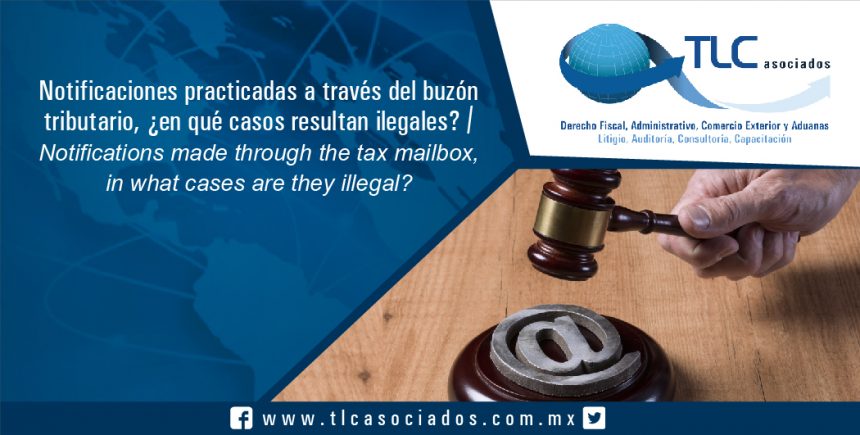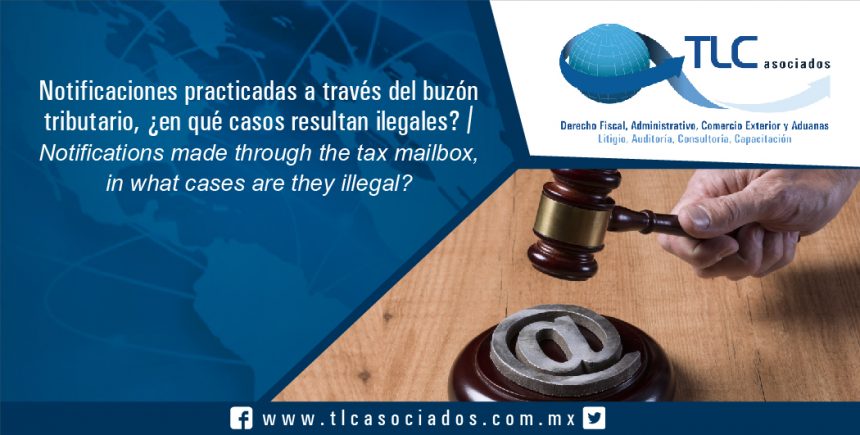
098 – Notificaciones practicadas a través del buzón tributario, ¿en qué casos resultan ilegales? / Notifications made through the tax mailbox, in which cases are they illegal?
Ciudad de México, junio 2017.
Buzón Tributario. – Las reglas 2.2.6 y 2.2.7 de la resolución miscelánea, incumplen con la exigencia del artículo 17-K del Código Fiscal de la Federación.
En jurisprudencia publicada en días pasados, el Poder Judicial de la Federación determinó que las reglas 2.2.6 y 2.2.7 de la resolución miscelánea fiscal, son ilegales por incumplir con la obligación prevista en el artículo 17-K, último párrafo, del Código Fiscal de la Federación, donde se señala que las personas físicas y morales que tengan asignado un buzón tributario deberán consultarlo dentro de los tres días siguientes a aquél en que reciban un aviso electrónico enviado por el Servicio de Administración Tributaria mediante los mecanismos de comunicación que el contribuyente elija de entre los que se den a conocer mediante reglas de carácter general.
Sin embargo, el Ejecutivo Federal pretendió cumplir lo ordenado por el artículo 17-K, por medio de las citadas reglas 2.2.6. y 2.2.7, pero dispuso de un solo medio de comunicación, que es el correo electrónico, con lo cual, evidentemente no satisface la instrucción legislativa de que sean dos o más medios de comunicación como elegibles u opcionales para el contribuyente, pues no es suficiente la expresión que señala: “…para elegir el mecanismo de comunicación los contribuyentes ingresarán al menos una dirección de correo electrónico y máximo cinco…”, ya que aunque el particular cuente hasta con cinco correos electrónicos, ello no constituye los diferentes mecanismos de comunicación a que obliga el artículo 17-K mencionado y, por tanto, las reglas de carácter general aludidas son ilegales.
Los anteriores razonamientos son contenidos en la jurisprudencia cuyo rubro es; “BUZÓN TRIBUTARIO. LAS REGLAS 2.2.6. Y 2.2.7. DE LAS RESOLUCIONES MISCELÁNEA FISCAL PARA 2015 Y 2016, RESPECTIVAMENTE, AL PREVER UN SOLO MEDIO DE COMUNICACIÓN PARA QUE LOS CONTRIBUYENTES QUE CUENTEN CON AQUÉL RECIBAN LOS AVISOS ELECTRÓNICOS ENVIADOS POR EL SERVICIO DE ADMINISTRACIÓN TRIBUTARIA, INCUMPLEN LA OBLIGACIÓN CONTENIDA EN EL ARTÍCULO 17-K, ÚLTIMO PÁRRAFO, DEL CÓDIGO FISCAL DE LA FEDERACIÓN”.
La decisión del Poder Judicial de la Federación, permite concluir que la autoridad fiscal en la presente fecha aún no está cumpliendo con la exigencia del artículo 17-K, último párrafo, del Código Fiscal de la Federación, e inclusive pudiere inferirse que las notificaciones practicadas a través del buzón tributario resultan ilegales.
Sin otro asunto en particular quedamos a sus órdenes para cualquier duda o aclaración respecto de la presente información.
Atentamente
División Legal
TLC Asociados, S.C.
tlcnegocios@www.tlcasociados.com.mx
Prohibida la reproducción parcial o total. Todos los derechos reservados de TLC Asociados, S.C. El contenido del presente artículo no constituye una consulta particular y por lo tanto TLC Asociados, S.C., su equipo y su autor, no asumen responsabilidad alguna de la interpretación o aplicación que el lector o destinatario le pueda dar.
June 2017 in Mexico City.
Tax Mailbox. – The rules 2.2.6 and 2.2.7 of the miscellaneous resolution do not comply with the demand of the article 17-K of the Fiscal Code of the Federation.
In a Jurisprudence published in the last days, the Federal Judiciary Branch determined that the rules 2.2.6 and 2.2.7 of the fiscal miscellaneous resolution are illegal because they do not comply with the obligation stated in the article 17-K, last paragraph, of the Fiscal Code of the Federation, where it is indicated that the natural and legal entities that have a tax mailbox must consult it within the following three days of the day when an electronic notice sent by the Tax Administration Service is received through the mechanisms of communication that the taxpayer chooses from the ones informed by means of general character rules.
However, the Federal Executive intended to comply the ordered by the article 17-K, by means of the mentioned rules, 2.2.6 and 2.2.7, but disposed of only one means of communication, which is the email, therefore, it evidently does not satisfy the legislative instruction of being two or more means of communication as eligible or optional for the taxpayer, since the next expression is not enough: “…to choose the mechanism of communication the taxpayers will enter at least one email address and a maximum of five…”, since, although the individual had five email addresses, this does not constitute the different mechanisms of communication that the mentioned article 17-K obliges and, therefore, the general character rules are illegal.
The prior reasoning is contained in the jurisprudence under the heading; “TAX MAILBOX. THE RULES 2.2.6 AND 2.2.7 OF THE FISCAL MISCELLANEOUS RESOLUTION FOR 2015 AND 2016, RESPECTIVELY, SINCE IT PROVIDES ONLY ONE MEANS OF COMMUNICATION FOR THE TAXPAYERS THAT HAVE IT RECEIVE THE ELECTRONIC NOTICES SENT BY THE TAX ADMINISTRATION SERVICE, THEY DO NOT COMPLY WITH THE OBLIGATION CONTAINED IN THE ARTICLE 17-K, LAST PARAGRAPH, OF THE FISCAL CODE OF THE FEDERATION”.
The decision of the Federal Judiciary Branch enables to conclude that the fiscal authority up to today is not complying with the requirement of the article 17-K, last paragraph, of the Fiscal Code of the Federation, and it could even be concluded that the notifications made through the tax mailbox are illegal.
Without anything else at this moment, do not hesitate to contact us.
Sincerely,
Legal Division
TLC Asociados, S.C.
tlcnegocios@www.tlcasociados.com.mx
Partial or total reproduction is prohibited. All rights reserved to TLC Asociados, S.C. The content of this article is not a private consultation, therefore, TLC Asociados, S.C., and its team and author, are not responsible for any interpretation or use that the reader or recipient could give to it.

098 – Notificaciones practicadas a través del buzón tributario, ¿en qué casos resultan ilegales? / Notifications made through the tax mailbox, in which cases are they illegal?
Ciudad de México, junio 2017.
Buzón Tributario. – Las reglas 2.2.6 y 2.2.7 de la resolución miscelánea, incumplen con la exigencia del artículo 17-K del Código Fiscal de la Federación.
En jurisprudencia publicada en días pasados, el Poder Judicial de la Federación determinó que las reglas 2.2.6 y 2.2.7 de la resolución miscelánea fiscal, son ilegales por incumplir con la obligación prevista en el artículo 17-K, último párrafo, del Código Fiscal de la Federación, donde se señala que las personas físicas y morales que tengan asignado un buzón tributario deberán consultarlo dentro de los tres días siguientes a aquél en que reciban un aviso electrónico enviado por el Servicio de Administración Tributaria mediante los mecanismos de comunicación que el contribuyente elija de entre los que se den a conocer mediante reglas de carácter general.
Sin embargo, el Ejecutivo Federal pretendió cumplir lo ordenado por el artículo 17-K, por medio de las citadas reglas 2.2.6. y 2.2.7, pero dispuso de un solo medio de comunicación, que es el correo electrónico, con lo cual, evidentemente no satisface la instrucción legislativa de que sean dos o más medios de comunicación como elegibles u opcionales para el contribuyente, pues no es suficiente la expresión que señala: “…para elegir el mecanismo de comunicación los contribuyentes ingresarán al menos una dirección de correo electrónico y máximo cinco…”, ya que aunque el particular cuente hasta con cinco correos electrónicos, ello no constituye los diferentes mecanismos de comunicación a que obliga el artículo 17-K mencionado y, por tanto, las reglas de carácter general aludidas son ilegales.
Los anteriores razonamientos son contenidos en la jurisprudencia cuyo rubro es; “BUZÓN TRIBUTARIO. LAS REGLAS 2.2.6. Y 2.2.7. DE LAS RESOLUCIONES MISCELÁNEA FISCAL PARA 2015 Y 2016, RESPECTIVAMENTE, AL PREVER UN SOLO MEDIO DE COMUNICACIÓN PARA QUE LOS CONTRIBUYENTES QUE CUENTEN CON AQUÉL RECIBAN LOS AVISOS ELECTRÓNICOS ENVIADOS POR EL SERVICIO DE ADMINISTRACIÓN TRIBUTARIA, INCUMPLEN LA OBLIGACIÓN CONTENIDA EN EL ARTÍCULO 17-K, ÚLTIMO PÁRRAFO, DEL CÓDIGO FISCAL DE LA FEDERACIÓN”.
La decisión del Poder Judicial de la Federación, permite concluir que la autoridad fiscal en la presente fecha aún no está cumpliendo con la exigencia del artículo 17-K, último párrafo, del Código Fiscal de la Federación, e inclusive pudiere inferirse que las notificaciones practicadas a través del buzón tributario resultan ilegales.
Sin otro asunto en particular quedamos a sus órdenes para cualquier duda o aclaración respecto de la presente información.
Atentamente
División Legal
TLC Asociados, S.C.
tlcnegocios@www.tlcasociados.com.mx
Prohibida la reproducción parcial o total. Todos los derechos reservados de TLC Asociados, S.C. El contenido del presente artículo no constituye una consulta particular y por lo tanto TLC Asociados, S.C., su equipo y su autor, no asumen responsabilidad alguna de la interpretación o aplicación que el lector o destinatario le pueda dar.
June 2017 in Mexico City.
Tax Mailbox. – The rules 2.2.6 and 2.2.7 of the miscellaneous resolution do not comply with the demand of the article 17-K of the Fiscal Code of the Federation.
In a Jurisprudence published in the last days, the Federal Judiciary Branch determined that the rules 2.2.6 and 2.2.7 of the fiscal miscellaneous resolution are illegal because they do not comply with the obligation stated in the article 17-K, last paragraph, of the Fiscal Code of the Federation, where it is indicated that the natural and legal entities that have a tax mailbox must consult it within the following three days of the day when an electronic notice sent by the Tax Administration Service is received through the mechanisms of communication that the taxpayer chooses from the ones informed by means of general character rules.
However, the Federal Executive intended to comply the ordered by the article 17-K, by means of the mentioned rules, 2.2.6 and 2.2.7, but disposed of only one means of communication, which is the email, therefore, it evidently does not satisfy the legislative instruction of being two or more means of communication as eligible or optional for the taxpayer, since the next expression is not enough: “…to choose the mechanism of communication the taxpayers will enter at least one email address and a maximum of five…”, since, although the individual had five email addresses, this does not constitute the different mechanisms of communication that the mentioned article 17-K obliges and, therefore, the general character rules are illegal.
The prior reasoning is contained in the jurisprudence under the heading; “TAX MAILBOX. THE RULES 2.2.6 AND 2.2.7 OF THE FISCAL MISCELLANEOUS RESOLUTION FOR 2015 AND 2016, RESPECTIVELY, SINCE IT PROVIDES ONLY ONE MEANS OF COMMUNICATION FOR THE TAXPAYERS THAT HAVE IT RECEIVE THE ELECTRONIC NOTICES SENT BY THE TAX ADMINISTRATION SERVICE, THEY DO NOT COMPLY WITH THE OBLIGATION CONTAINED IN THE ARTICLE 17-K, LAST PARAGRAPH, OF THE FISCAL CODE OF THE FEDERATION”.
The decision of the Federal Judiciary Branch enables to conclude that the fiscal authority up to today is not complying with the requirement of the article 17-K, last paragraph, of the Fiscal Code of the Federation, and it could even be concluded that the notifications made through the tax mailbox are illegal.
Without anything else at this moment, do not hesitate to contact us.
Sincerely,
Legal Division
TLC Asociados, S.C.
tlcnegocios@www.tlcasociados.com.mx
Partial or total reproduction is prohibited. All rights reserved to TLC Asociados, S.C. The content of this article is not a private consultation, therefore, TLC Asociados, S.C., and its team and author, are not responsible for any interpretation or use that the reader or recipient could give to it.
Search
Nuestros servicios
- División de Auditoria Preventiva y de Cumplimiento
- División de Certificaciones OEA-NEEC-CTPAT
- División de Certificación en Materia de IVA/IEPS y Recinto Fiscalizado Estratégico
- División de Blindaje Legal
- División de Consultoría
- División de Lobbying
- Gestoría de Permisos Especiales
- Arquitectura Aduanera
- Revista TLC
- Libros TLC
